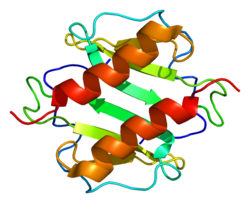CXCL1
Zur Navigation springen
Zur Suche springen
| CXCL1 | ||
|---|---|---|

| ||
| nach PDB 1MGS | ||
| Andere Namen |
| |
| Eigenschaften des menschlichen Proteins | ||
| Masse/Länge Primärstruktur | 107 Aminosäuren, 11301 Da | |
| Bezeichner | ||
| Externe IDs | ||
| Vorkommen | ||
| Homologie-Familie | Hovergen | |
CXCL1 ist ein Zytokin aus der Familie der CXC-Chemokine.
Eigenschaften[Bearbeiten | Quelltext bearbeiten]
CXCL1 wird unter anderem von Makrophagen, Neutrophilen und Epithelzellen gebildet.[1][2] CXCL1 bindet Neutrophile an Orten der Entzündung.[3][4] CXCL1 ist an der Entwicklung des Rückenmarks (hemmt dort die Wanderung der Oligodendrozyten-Vorläuferzellen), der Angiogenese, der Entzündung, der Wundheilung und der Entstehung von Tumoren beteiligt.[5][6][7][8]
CXCL1 ist mitogen und an der Pathogenese von Melanomen beteiligt.[9][10]
CXCL1 wird durch den Rezeptor CXCR2 gebunden.[5] Das CXCL1-Gen liegt in einem Gen-Cluster mit Genen von anderen CXC-Chemokinen.[11]
Einzelnachweise[Bearbeiten | Quelltext bearbeiten]
- ↑ N. Iida, G. R. Grotendorst: Cloning and sequencing of a new gro transcript from activated human monocytes: expression in leukocytes and wound tissue. In: Mol. Cell. Biol. 10. Jahrgang, Nr. 10, Oktober 1990, S. 5596–5599, PMID 2078213, PMC 361282 (freier Volltext).
- ↑ S. Becker, J. Quay, H. S. Koren, J. S. Haskill: Constitutive and stimulated MCP-1, GRO alpha, beta, and gamma expression in human airway epithelium and bronchoalveolar macrophages. In: Am. J. Physiol. 266. Jahrgang, 3 Pt 1, März 1994, S. L278–L286, PMID 8166297.
- ↑ B. Moser, I. Clark-Lewis, R. Zwahlen, M. Baggiolini: Neutrophil-activating properties of the melanoma growth-stimulatory activity. In: J. Exp. Med. 171. Jahrgang, Nr. 5, Mai 1990, S. 1797–1802, doi:10.1084/jem.171.5.1797, PMID 2185333, PMC 2187876 (freier Volltext).
- ↑ C. Schumacher, I. Clark-Lewis, M. Baggiolini, B. Moser: High- and low-affinity binding of GRO alpha and neutrophil-activating peptide 2 to interleukin 8 receptors on human neutrophils. In: Proc. Natl. Acad. Sci. U.S.A. 89. Jahrgang, Nr. 21, November 1992, S. 10542–10546, doi:10.1073/pnas.89.21.10542, PMID 1438244, PMC 50375 (freier Volltext).
- ↑ a b H. H. Tsai, E. Frost, V. To, S. Robinson, C. Ffrench-Constant, R. Geertman, R. M. Ransohoff, R. H. Miller: The chemokine receptor CXCR2 controls positioning of oligodendrocyte precursors in developing spinal cord by arresting their migration. In: Cell. 110. Jahrgang, Nr. 3, August 2002, S. 373–383, doi:10.1016/S0092-8674(02)00838-3, PMID 12176324.
- ↑ R. M. Devalaraja, L. B. Nanney, J. Du, Q. Qian, Y. Yu, M. N. Devalaraja, A. Richmond: Delayed wound healing in CXCR2 knockout mice. In: J. Invest. Dermatol. 115. Jahrgang, Nr. 2, August 2000, S. 234–244, doi:10.1046/j.1523-1747.2000.00034.x, PMID 10951241, PMC 2664868 (freier Volltext).
- ↑ H. Haghnegahdar, J. Du, D. Wang, R. M. Strieter, M. D. Burdick, L. B. Nanney, N. Cardwell, J. Luan, R. Shattuck-Brandt, A. Richmond: The tumorigenic and angiogenic effects of MGSA/GRO proteins in melanoma. In: J. Leukoc. Biol. 67. Jahrgang, Nr. 1, Januar 2000, S. 53–62, PMID 10647998, PMC 2669312 (freier Volltext).
- ↑ J. D. Owen, R. Strieter, M. Burdick, H. Haghnegahdar, L. Nanney, R. Shattuck-Brandt, A. Richmond: Enhanced tumor-forming capacity for immortalized melanocytes expressing melanoma growth stimulatory activity/growth-regulated cytokine beta and gamma proteins. In: Int. J. Cancer. 73. Jahrgang, Nr. 1, September 1997, S. 94–103, doi:10.1002/(SICI)1097-0215(19970926)73:1<94::AID-IJC15>3.0.CO;2-5, PMID 9334815.
- ↑ A. Anisowicz, L. Bardwell, R. Sager: Constitutive overexpression of a growth-regulated gene in transformed Chinese hamster and human cells. In: Proc. Natl. Acad. Sci. U.S.A. 84. Jahrgang, Nr. 20, Oktober 1987, S. 7188–7192, doi:10.1073/pnas.84.20.7188, PMID 2890161, PMC 299255 (freier Volltext).
- ↑ A. Richmond, H. G. Thomas: Melanoma growth stimulatory activity: isolation from human melanoma tumors and characterization of tissue distribution. In: J. Cell. Biochem. 36. Jahrgang, Nr. 2, Februar 1988, S. 185–198, doi:10.1002/jcb.240360209, PMID 3356754.
- ↑ A. Richmond, E. Balentien, H. G. Thomas, G. Flaggs, D. E. Barton, J. Spiess, R. Bordoni, U. Francke, R. Derynck: Molecular characterization and chromosomal mapping of melanoma growth stimulatory activity, a growth factor structurally related to beta-thromboglobulin. In: EMBO J. 7. Jahrgang, Nr. 7, Juli 1988, S. 2025–2033, PMID 2970963, PMC 454478 (freier Volltext).